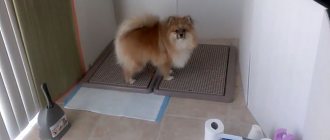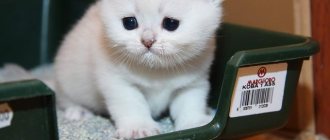At what age should you start litter box training?
If you buy a kitten from professional breeders, most likely it will already be trained to shit in the right place.
If not, you will have to teach yourself. You should start at about three weeks of age. It is advisable to buy a tray and filler before you bring the animal into the house, so that it immediately gets used to it. It’s not difficult to train, the main thing is to strictly follow our recommendations and be patient.
There is no point in looking for a separate article on how to accustom a street kitten to a litter box, since a kitten is also a kitten in Africa, that is, it doesn’t matter where you got it: you picked it up on the street or bought it from a breeder, the methods are the same.
The most important thing is that the cat litter box is in a place where the kitten can have privacy. Access to a bowel movement container must be available 24 hours a day. Basically, cat litter is installed in the restroom. It is important to remember that now you have a pet, do not forget to leave the door to the toilet open.
There is simply no universal method for litter training kittens and adult cats, because the characters of animals, like people, can be very different. But taking into account all the recommendations will significantly speed up the process, helping to achieve the desired results.
It is much easier to train a kitten, because its character and habits are just being formed. If a decision is made to adopt an adult cat, then it is not a fact that he will agree to use the toilet where the new owner shows him. You will need affection and patience towards the animal, attention and love will soon give their results.
For kittens, sand or wood composition of commercial brands is more suitable as a filler. For older cats, the filler is selected taking into account his habits and preferences. If the owner notices that the cat is restless and is looking for a place to use the toilet, you should immediately take it to the litter box. If she runs away, it's enough to calmly return her there until she goes to the toilet.
After a few days and after a couple of successful attempts, the animal will get used to it and begin to perceive the litter box as the only place in the house to go to the toilet.
Reference!
As for the breed, there are no differences: it doesn’t matter whether you have a Sphynx, British or Scottish Fold - the training process is completely the same.
Very young kittens are used to being near their mother; they do not yet know how to lick themselves and do not have many important skills; their gait is unsteady. Of course, it is more difficult to toilet train such a child, since the work of his unconditional instincts is still incomplete. Usually the mother cat, if she is nearby, teaches the baby to the right place.
The ideal option for self-study is after 2-2.5 months, but not later than 3-4, then habits are formed. At the same age, the process of accustoming to trimming nails should begin.
After 2.5 months, the kitten matures, gains confidence, but its character is still being formed, so it is easiest to accustom your pet to the litter box at this age.
Despite such an early age, with perseverance and care, even a baby can be easily toilet trained. Some veterinarians recommend doing this as early as 4 weeks, so that the baby does not start shitting wherever he wants, but immediately understands that there is a tray.
It is recommended to choose purchased compounds as a filler, as they have the property of instant absorption, and the kitten’s paws and fur will always remain clean.
Teaching your pet to leave the apartment on his own
It is possible to teach a cat living in an apartment to go outside on his own, but it is not always recommended. This is especially true in cases where stray dogs may be walking in the yard. Cats may not leave the apartment in a number of cases:
- strong fear (dangers waiting on the street);
- fear of not returning home.
Having decided to teach your cat to walk outside on his own, leaving the apartment, you need to be patient and act gradually. To begin with, you need to pick up the cat and take him out for no more than 5-10 minutes. Then the time is increased, and when the cat gets used to it, you can start learning to walk on a leash. You need to pick up a special harness at a pet store and take your first walks in an apartment. Veterinary experts do not recommend leaving your pet unattended for a long time, and also not walking it without a harness. On the street, a cat may be frightened by a dog (at best) or by a sharp sound.
Features of training a street kitten
How quickly a kitten will learn to use the litter box depends on how quickly he understands what is required of him. Your task is to closely monitor your pet. When you notice that the animal wants to go to the toilet, quickly carry it to the tray, sit it down, pet it and do not let it out until it has done “its business” there.
How to understand that a kitten wants to go to the toilet? He begins to rush around the room restlessly, meowing, sniffing in search of a suitable place.
First, wear it every time after eating or sleeping. When the fluffy relieves himself in his toilet, praise him and show your satisfaction. In most cases, the kitten begins to go to the litter box on its own within 2 weeks.
Sometimes it happens that owners try for months to stop their pet from shitting all over the apartment, and nothing works. As a result, they again begin to look for information about methods of litter box training in an apartment. There are many reasons for this:
- If you can’t train it, first of all replace the filler (preferably with a more expensive and high-quality one). Also keep in mind that some kittens like sand, others like newspapers, and still others prefer nothing at all inside.
- There is also a possibility that for some reason the pet does not like the tray itself.
- Change the location of the litter box and place the cat litter box in a secluded area.
- The smell of chemicals can scare away a cat, so it is better to wash the cat litter with warm soapy water, without resorting to strong chemicals.
It's actually not difficult to wean off. The easiest option is to make this place impregnable. But if this is not possible, there are several more effective methods:
- Treat the cat's favorite area with deodorant, perfume, or something else that smells strongly. This will scare the animal away.
- put down a wet rag or a lot of crumpled paper.
- when you notice that the kitten has gone to shit where it shouldn’t, scare it away with a loud bang.
Do not hit a small pet under any circumstances; there is no point in poking its face into a puddle of urine either. As punishment, squeeze the animal's ear with your nails until it meows. Then take him to the tray and pet him.
You can punish only when the kitten is caught doing his “dirty deeds.” Otherwise, he will not understand what crime was punished. For example, you came home from work as a lady and saw puddles or piles... In this case, it is useless to scold, too much time has passed.
We suggest you read: How to accustom a cat to water. Practical advice. How to teach a cat not to be afraid of bathing
It would be more reasonable to soak the newspaper in the puddle and put it in the tray (if you find a pile, put it there too). Then we take the kitten and put it in the tray, let it sniff and pet it.
Everything is not as complicated as it might seem at first glance. The main thing is to be restrained and patient, do not lash out at a small animal.
The process of raising a kitten should begin from the first moments of its appearance in the apartment. If you hesitate, the risk of developing bad habits increases, including going to the toilet wherever you have to. We also recommend taking care of housing for the kitten, and if you have problems with the kitten’s affection: pay attention to the article on how to stop a kitten from biting and scratching.
Adviсe
So, to train a kitten to use a litter tray, you will need to follow some rules:
- Prepare a tray and pour filler into it. After waking up or eating, you should put your pet in the tray.
- It is recommended to try to drip the filler with your pet’s paws in order to activate the instinct when the baby himself understands what they want from him.
- If your pet went to the toilet in the wrong place, you should not yell at it. Simply soak a napkin in the urine and place it in the tray.
- If the place is not intended for urination, it must be thoroughly washed to remove odors; special repellent sprays can be used.
- Also, to train to a tray, you can limit the animal’s movement space to one room where the tray is located.
- If the kitten does not like the chosen place for the toilet, you should change it, moving it to where he usually sits down to go to the toilet. Every day, gradually move the tray to its original location.
- You should carefully consider the choice of filler. Cats also have their own preferences.
- When using, it is important to carefully study the manufacturer’s recommendations on the packaging regarding the frequency of changes, etc. For example, silicone filler is replaced completely less often than clay or wood filler.
- A kitten should be praised for good behavior. He will feel goodwill and then try to repeat his actions to obtain a similar reaction from the owner.
Important!
If the kitten was properly trained, but suddenly stopped going to the litter box, you should try to immediately explain to the pet in a decisive tone, looking into the eyes, that this cannot be done.
There are many reasons, but the main ones are listed below:
- Washing the tray with products with strong chemical-repulsive odors. Cats have a delicate sense of smell, and a small kitten may simply not understand and be frightened by an unfamiliar strong aroma, starting to look for a place for the toilet where it is not supposed to.
- You should not punish a cat near the litter box; the toilet should not be associated with negativity, otherwise the animal will stop approaching it, avoiding it in all possible ways.
- You should not wash or dry your animal immediately after using the toilet. Cats wash themselves, and if dirt still remains, then after half an hour you can carry out the procedure.
- Sometimes even adult animals ignore the toilet, but then this may be a symptom of a disease - for example, a worm infestation. In such a situation, it is better to take your pet to the veterinarian once again.
Street kittens, despite their small age, have already managed to live on the street, where they were not required to go to the toilet in a specific place.
Important!
If a person decides to adopt a pet from the street, it is necessary to take into account the fact that the kitten’s character has already been formed and will have to spend a little more time and effort to train it to the toilet, as well as to wean it from other bad habits.
In such a situation, all methods will come to the rescue, the main thing is to choose the appropriate one. Most kittens from the street are very smart, they immediately respond correctly to the tray and filler. We must not forget that manufacturers of litter take into account the odor factor, making it attractive to cats so that the instinct to go to the toilet is triggered. If the pet is stubborn, then already known tricks with citrus fruits or the use of an aerosol will come to the rescue.
The most comfortable living conditions for any cat is a private home. Here the problem with the toilet can be solved quickly - just let the animal out into the yard (if you also build an outdoor house, then there will be no problems at all). To do this, you can make a special exit at the bottom of the door or come up with other designs so as not to constantly open the front door.
Reference!
But this method is not always good. If the kitten is an expensive breed, then you shouldn’t even let it out into the yard, so even in a private house you will have to teach your pet to go to the litter box.
First of all, the size and height of the sides are selected depending on the physiological characteristics of the kitten.
Some owners buy and install two different types of trays to determine which one is more suitable. In addition, the use of two trays simplifies cleaning and replacing the filler.
The owner will not be able to teach the kitten to lick itself. This is a natural reflex that develops spontaneously in cats from childhood. If you even look at kids, they gradually acquire this skill, carrying out the process better and better. In this regard, the owners are powerless, everything will happen by itself, there is no need to interfere.
You can quickly train a cat to use a litter box only if you were already familiar with it before you arrived. It is enough to show her the tray where it is, and the problem will be solved. But if you got a very impressionable cat, and the fright after the move greatly affected her, then you need to wait a little. In a couple of days she will get used to it, calm down and remember what a litter box is and how to go into it.
But an adult cat taken from the street, and even one with character, may not even approach the tray in the apartment offered to Her Majesty and goes where her darling pleases. Interaction with such an animal will require more patience, understanding, calmness, love and care on the part of the owner.
We suggest you read: How to train a cat to use the toilet
With kittens the situation is simpler. They quickly catch why they are put in a tray. Well, if the kitten is adopted from a shelter, then you can relax. A professional breeder gives the kitten to the owners, accustoming it to a tray and teaching it to eat food. The owners only need to find out which filler is best to purchase.
If the furry baby you purchased sees the tray for the first time, then take this fact for granted and start training it like real trainers.
Do not worry! Cats are naturally clean and will master this science. The main thing is to start teaching from the day the baby appears in your home.
What not to do
Under no circumstances should you punish your pet. If you start poking your animal’s nose into his feces, he will not understand that he is being scolded for going to the toilet in the wrong place; he will simply regard this as a punishment for a completed physiological act. In the future, the cat will hide from you in more secluded places in order to carry out its “dirty deeds”.
You should not forcefully hold your pet in the tray while waiting for him to go to the toilet. The animal will simply get scared and will avoid the tray.
The cat will definitely understand what they want from him - you just need to be affectionate towards your pet. It is not an easy task to accustom an outdoor cat to a litter box, and the result will depend on how you behave. The main key to success is patience; after a certain amount of time, the cat will definitely figure out what to do, and you will find happiness and peace.
Necessary purchases
An adult pet who has not previously been potty trained should also like the design of the new toilet. The tray should not only be spacious (suitable in size for certain animal sizes), but also comfortable.
There are two main types:
- closed structures;
- open trays.
Closed structures are an isolated structure (most often in the form of a house with a door or window), with special filters installed in it to retain unpleasant odors. Such modern trays are very convenient and attractive. An adult cat performs all delicate procedures without any problems, hiding from strangers. This design can be placed not only in the bathroom, but also in the corridor, there will be no smells or inconveniences.
Freedom-loving pets who previously relieved themselves in nature are unlikely to agree to the small confined space of a new tray. Closed litter boxes for cats are quite difficult to clean, because the entire structure will have to be disassembled and reassembled. If the animal has health problems, this procedure will have to be carried out regularly, several times a day.
It is much easier to train your cat to use an open litter box. Wide and comfortable deep designs greatly simplify the training process. There are high-sided litter boxes that allow your pet to bury their waste, and low-sided litter boxes that are better suited for smaller cats and kittens. Also, open trays come with or without bars.
When arranging a cat litter box, the choice of litter is of great importance. This is a real find for those pet owners who are away from home most of the day. The structure of the filler allows all liquid to be absorbed, reliably locking in all odors. Lack of filler is unhygienic and inconvenient.
Useful video
When we get a pet, the first thing we think about is how to train a cat to use the litter box. Not every animal is able to understand from the first days which place is intended as a toilet. Many people are faced with the fact that animals use a bathtub, carpet, or any kind of rags.
As a result, a characteristic smell appears in the apartment, which is not so easy to get rid of. Sometimes it takes a lot of patience and knowledge on how to train a cat to use a litter box. It is extremely important to choose the right tray, filler for it and a place to relieve the animal’s needs.
- The advantage of an open tray is its convenience. The tray is a bowl into which a mesh is inserted, which can be easily removed when cleaning. When choosing, give preference to trays with a wide bottom and high sides. The dimensions of the tray depend on the size of your pet.
- The cat must fit completely into the bowl. We do not recommend using sawdust as a filler because it is impractical, since the animal will spread it throughout the room. It is better to opt for granular fillers.
- The closed tray is different in that it looks like a house with an entrance to it. This type of tray will allow you to hide the process from prying eyes. However, remember that it will be quite difficult to train an outdoor cat to a closed litter box.
- It is best suited for tiny kittens. Another disadvantage of the tray is the complexity of its design, which will have to be assembled and disassembled every day for cleaning.
- The most optimal in terms of price-quality ratio are wood or clay based fillers. They perfectly absorb liquid and absorb odor.
- Use the above-mentioned fillers only during the period of accustoming the cat to the tray, since clay will constantly stain its paws and, accordingly, your apartment, and wood tends to crumble.
- Once you have figured out how to train your cat to use the litter box, replace the litter with silicone. It will cost more, but the granules have a higher absorbency.
- It is better to choose larger granules. They will prevent urine from seeping into the bottom of the tray and it will remain dry. Your pet will be able to use the toilet several times and not disdain it.
Most cat owners think about how to train their cat to use the litter box in the bathroom. Perhaps this place can really be considered an ideal option.
However, if you just brought the animal home, it may be frightened by the sounds of a washing machine or a flushing toilet. For the first days of your animal's life in your home, you can place the tray in a quiet and secluded place, such as a hallway.
Well, if you don’t want to read all this, watch the video with people’s real experiences about how they trained their pet to use the litter box.
Some external signs can help the new owner train the pet to use the litter box.
- If the cat starts looking for a secluded place, sniffing corners, scratching its paws and fussing - these are sure signs that the pet wants to go to the toilet. In this case, it is necessary to transfer the cat to the tray as soon as possible. If the procedure was successful, be sure to praise the animal.
- If the cat has chosen a place and is already paving, then it is also necessary to quickly move the animal to the toilet. At the same time, you should not make sudden movements, because you can scare the delicate creature, causing severe stress before going to the tray.
- If trouble has already occurred, and traces of the cat’s vital activity are observed on the floor in the room, then you should not angrily scold your pet. You should carefully remove the puddle with newspaper or paper, and place the waste in a tray. Its own scent will help the cat navigate the space and find its toilet without any problems next time.
- It is common for both kittens and adult cats to go to the toilet immediately after eating or sleeping. You can regularly remind your pet of the sequence of actions, and in the future you will be able to train your cat to use the toilet quite easily.
Some owners do not want to use cat litter in their cat litter. This is a personal matter for everyone. But in this case, training adult cats to use the litter box may take a little longer. Clean pets do not like dirty toilets, and they are unlikely to want to go to a dirty litter box twice a day. Which, naturally, will lead to an unexpected puddle on the floor.
If the animal is already familiar with its potty, but previously there was filler in it, then the only way to accustom the pet to new conditions is to gradually reduce the amount of filler. Soon you can completely eliminate foreign materials from the tray. But again, there will be a problem of regular cleaning of the toilet.
We suggest you read: How to accustom a Chihuahua to a diaper and litter tray? Ways to toilet train him at home. How to stop a puppy from peeing anywhere?
It is much easier to accustom an adult cat to a new litter box with sand or wood litter. It is necessary to show the animal a place to perform delicate procedures, scrape your paw on the sawdust. If possible, you should take some litter from your pet's old litter box; the cat's own smell will attract the cat to the new location of the litter box. In this case, it will not be difficult to train your cat.
It is better to introduce your cat to the toilet immediately upon arrival at its new home. This will help avoid stress for the animal. Some mistakes at first are not a big deal. Only regular embarrassments in inappropriate places should be of concern.
First of all, in order to quickly accustom a cat to the litter box, you must understand that representatives of the feline family are extremely clean, so the cat’s litter box must be constantly clean. Otherwise, the cat will find another place to relieve itself.
Cats love to do their “business” in secluded places. So if the sewer is constantly knocking near her toilet, the washing machine is rattling, shampoos are falling from the shelves, the pet will avoid visiting this place in every possible way.
Orange peel
Cats hate citrus fruits. All you have to do is scatter orange peels in corners and other places where your pet prefers to shit, then he won’t come anywhere near there.
Lavender
Lavender has the opposite effect of orange peels, meaning it attracts cats. You need to treat the toilet with it so that it attracts the fluffy one.
Pet stores sell sprays designed to repel and attract cats. So, we treat the places in the apartment where the animal has pooped with a deterrent, and its toilet with an attractant. Most likely the effect will be better than that of orange peels and lavender.
Unacceptable errors
All cats naturally love stability, so even a slight movement of the litter box can put them into a state of stress. Moreover, many representatives of the cat world are very reluctant to get used to going to the toilet outside. Therefore, during training, the owner should not make common mistakes:
- Punish a cat for being stubborn . A slight increase in voice or a stern look with words of reproach can greatly offend your pet. Wrong, reckless actions of the owner will nullify any attempts to accustom the mustachioed-striped dog to a new toilet. It is also forbidden to scold a pet for going to the toilet past the tray if its location has been changed or taken out of the house. Training a cat to use the toilet outside is a process that requires maximum calm and patience from a person.
- Rejoice loudly when the cat goes to the outdoor toilet . The fact is that cats perceive praise differently than dogs; on the contrary, it can scare them.
- Show pity. When it’s cold outside, it’s strictly forbidden to cut your pet some slack and return his litter box to the house. Having done this once, the cat will constantly demand its way, and may even deliberately cause mischief so that the owner will return the tray to the house. If a cat categorically refuses to go outside to the litter box in bad weather, all the owner can do is place a garbage bag at the location of the old toilet to make it easier to clean up after the animal.
Before you accustom your pet to the outdoor toilet, you need to weigh all the risks. The yard should be well protected; there should be no passing cars, noisy children or strangers nearby.
How to accustom an adult cat to a new toilet tray
Usually, those who adopt a kitten do not have any particular problems in teaching the fluffy to go strictly to the litter box. Because breeders often prepare their babies to do all this in the right place. Not even the breeders, but the mother cat. And a completely different question is how to accustom an adult cat to the litter box.
Today Koshechka.ru will share with you some tricks.
We all know the expression that a cat, especially an outdoor one, walks on its own. Let her walk, but you watch her carefully and catch those moments when she wants to go to the toilet.
How to understand this? Yes, very simple. The pet will begin to behave restlessly, meowing and sniffing in search of a place. Take it to the tray.
It is also worth offering him to go to the toilet every time after the cat eats or sleeps.
The reasons may vary.
- For example, a pet does not recognize the filler. It is best to choose the one that is more expensive, it is considered to be of better quality. But here, too, everything is not for everyone. For example, a cat you adopted from the street could have previously lived in an apartment where he was trained to go to an empty litter box. It happens that a cat likes to go to the newspaper. And for those who are completely outdoors, give them sand or even earth. Then take care of the flower pots, because the newly adopted pet can make a toilet even there.
- And sometimes the filler, even the new one, has nothing to do with it. The problem is in the product you use to clean the cat litter. It is better not to use caustic chemicals, but to give preference to plain soapy water.
- Another reason is that the pet is not happy with which tray it is, for example, if you bought a new one.
- It happens that you need to put the tray in another place. Sometimes a cat will not go to relieve itself in a place that is not private.
You must understand the fact that cats are extremely intelligent creatures, so even a stray animal can be trained to defecate in one place. As in the case of a kitten, an adult cat litter box should be placed in a secluded place, with 24-hour access provided. Then buy a good litter (or use sand). Take your choice of litter seriously; each cat has its own preferences.
The easiest way to train a pet to use a litter box is if it has been using it all its life. You need to retrain it, for example, if you move (or your pet was given to you for some reason). The main thing is to provide the same conditions as before. To do this, ask the former owners what kind of tray it was, what filler it was, where it was located, etc. All this is very important, cats become very accustomed to a certain way of life, and it is extremely difficult to change their habits.
The most difficult thing is with street cats who already have ingrained habits and have never seen a litter box in their lives.
Training aids
Since all owners want to accustom their cat to the litter box quickly and forever, they often begin searching for aids. Special sprays can be good helpers. There are two types of pharmaceuticals:
- with an attractive effect;
- with a repellent effect.
The principle of operation of the first type of products is based on the fact that their smell attracts the cat, forcing it to go to the toilet in the right place. The secret of this effect is simple: it contains urea, in other words, urea. Therefore, some cat owners do not want to purchase an aerosol; they simply moisten a napkin with the animal’s urine and place it in the right place. But using a spray is much more convenient, and such preparations are inexpensive. The product should be sprayed around the tray: on a piece of paper left nearby, or on the filler itself.
Sprays with a repellent effect are used to treat potentially at-risk areas, such as shoes, places behind furniture, and rugs. It is also recommended to use them in areas where the animal has already left a puddle.
All specialized products are absolutely safe for cats. But there are people who prefer folk remedies, for example, lavender oil. Use a few drops in the place where the animal gets into the habit of going to the toilet - the aroma repels cats well.
Citrus fruits also seem unpleasant to cats - you can leave the peels of oranges or tangerines in the place where the animal has shitted several times.
How to train a cat to use the litter box? A selection of tips
Currently, a wide range of cat litter fillers are offered, which differ in composition and properties. When choosing, it is recommended to consider the following:
- safety of the composition (environmentally friendly, hypoallergenic, impossible to get hurt or poisoned);
- no pungent odor;
- after use, the wool does not become dirty;
- absorbs moisture well, neutralizes odors;
- does not spread throughout the apartment, easy to clean;
- not a frequent replacement.
Using the litter, you can easily attract your cat's attention to the tray. Its rustling sound is very attractive.











